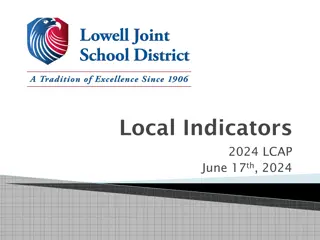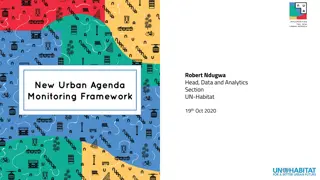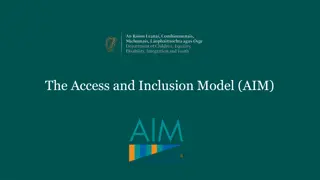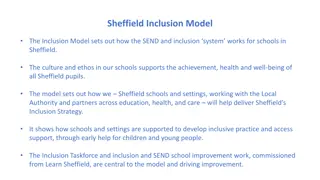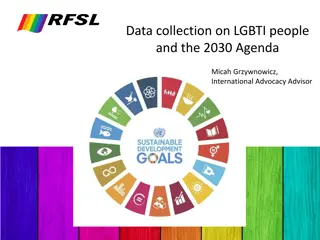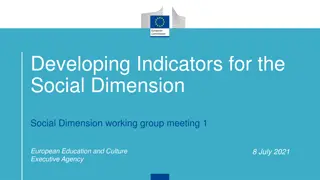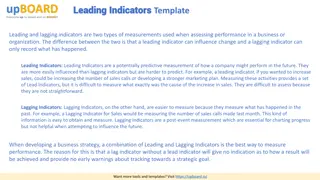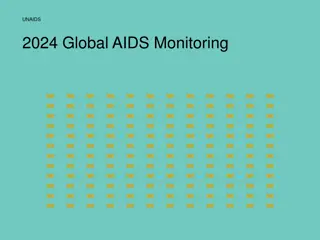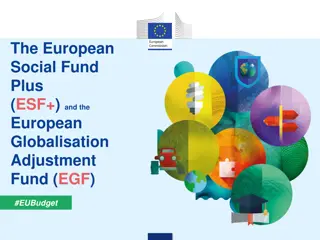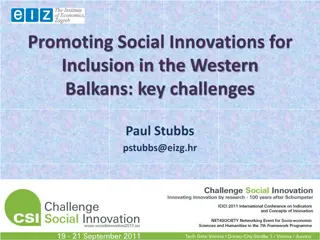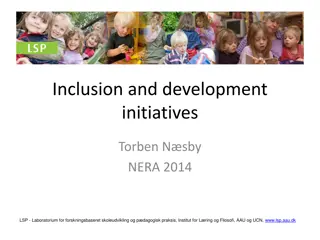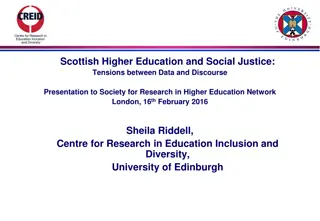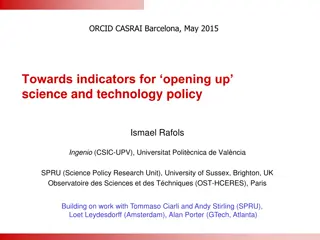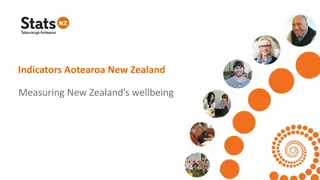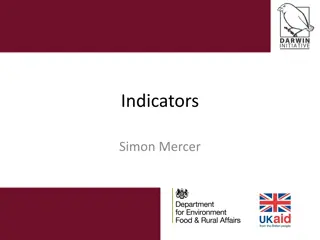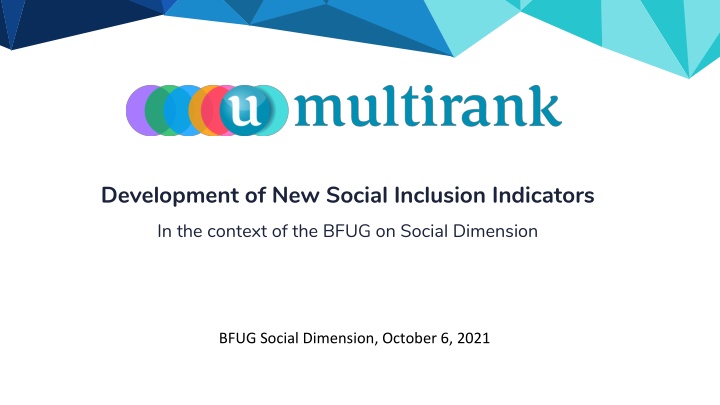
New Social Inclusion Indicators in Higher Education
Development of meaningful and internationally comparable indicators for social inclusion and sustainable development in higher education institutions. Investigating ways to measure social inclusion effectively. Reviewing policy documents, existing indicators, and stakeholder assessments to enhance societal impact and progress.
Download Presentation

Please find below an Image/Link to download the presentation.
The content on the website is provided AS IS for your information and personal use only. It may not be sold, licensed, or shared on other websites without obtaining consent from the author. If you encounter any issues during the download, it is possible that the publisher has removed the file from their server.
You are allowed to download the files provided on this website for personal or commercial use, subject to the condition that they are used lawfully. All files are the property of their respective owners.
The content on the website is provided AS IS for your information and personal use only. It may not be sold, licensed, or shared on other websites without obtaining consent from the author.
E N D
Presentation Transcript
Development of New Social Inclusion Indicators In the context of the BFUG on Social Dimension BFUG Social Dimension, October 6, 2021
Problem statement Higher education institutions are increasingly expected to contribute to societal issues. To measure their current contribution and progress over time, meaningful and internationally comparable indicators are needed. Aligned with policy and societal trends, we investigate new indicators for social inclusion and sustainable development (education).
Context U-Multirank First released in 2014, U-Multirank strives to provide multidimensional, transparent and user-driven ranking Users: HEIs, students, policy-makers Based on U-Map Next steps: develop benchmarking tool & new indicators umultirank.org
Research question I 1. How to measure social inclusion in higher education in a meaningful and internationally comparable way? Meaningful: Relevant Valid Feasible
Process & Results Paper ESD Paper social inclusion Paper effective T&L Expert worjshop Expert workshop expert workshop Advisory Board Steering Committee Steering Committee New questions Literature review Indicators needing further action Feasibility survey Social inclusion Education for Sustainable Development Effective teaching New entrants by: gender Age Disabilities Family background .. .. Pedagogically skilled staff Digital education investment Outreach programmes
Process Process for for Social Inclusion Social Inclusion 1. Review of relevant policy documents SDG s (#4, 5, 10) BFUG Social Dimension Renewed EU agenda for HE Council of Europe 2. Review of existing indicators in rankings/ projects THE Impact Ranking INVITED project 3. Indicator assessment by stakeholders Relevance Validity Feasibility
Social Inclusion: conceptual view Social Inclusion: conceptual view Outreach Access Progress Success Outcomes Interventions Non-tradit. Interventions Graduation Employment Policies Policies Policies Personal Well-being Underrepresented Disadvantaged Vulnerable Entrants compared to reference population Entrants compared to their peers in HE Entrants at risk of disadvantage
Existing UMR data on social inclusion CATEGORY INDICATOR Number of part-time programmes Number of part-time students Number of online programmes Number of female students Number of female PhD candidates Number of female PhD graduates Number of female academic staff Access measures Underrepresented groups (gender)
Proposed new indicators: Social inclusion CATEGORY INDICATOR Support services for underrepresented students (financial/housing) Quotas for students from underrepresented students Access measures Guidance/counselling/mentoring provided Policies for non-discrimination Tracking of application and acceptance rates First-generation Low socio-economic background Underrepresented students Migrant or indigenous Ethnic minorities Disabilities Mature
Proposed new indicators: Social inclusion underrepresented students UNDERREPRESENTED GROUPS INTERNAL REFERENCE EXTERNAL REFERENCE (IN ENTRANCE COHORT) % of entrance cohort or total enrolment % population in region (45-65) with higher education qualification First-generation Low socio-economic background % population in region with low socio-economic background % of total enrolment Migrant or indigenous % of total enrolment % population in region with migrant background Ethnic minorities % of total enrolment % population in region ethnic minorities Disabilities % of total enrolment % population in region with disabilities Mature % of total enrolment
Proposed new indicators: Social inclusion Table 2: Assessment of potential new indicators on social inclusion empty cells indicate that these criteria were not discussed in the expert meeting Expert consultation U-Multirank team high medium Indicator relevance validity feasibility relevance validity feasability low Outreach programmes Recognition of prior learning (alternative pathways) Quotas for students from under represented and/ or disadvantaged group Guidance/counselling/mentoring opportunities Support services for underrepresented and/or disadvantaged students Childcare facilities on campus for students with caring responsibilities HE access measures Maternity/Paternity policies Policies for non-discrimination Tracking of application and acceptance rates Students from low socioeconomic background Migrant or indigenous students Refugee students/ students seeking asylum Under- represented students Ethnic minorities Students with disabilities First-generation students Mature students Gender balance*
Feasability Figure 2: Breakdown by groups of new entrants: are data collected? (N=219)
Feasability Figure 3: Social inclusion in strategic plans: are data collected on (n=202):
Feasability policy data Table 3: Does your institution collect statistical data on the policies/plans mentioned before? POLICY MEASURE YES (%) NO (%) TOTAL (N) (N) (N) Underrepresented students admitted through outreach programs 44% 64 56% 81 145 Underrepresented students admitted through alternative pathways Underrepresented students admitted through a quota system 57% 65 43% 50 115 88% 80 12% 11 91 Underrepresented students benefiting from available support (e.g., financial, housing) Underrepresented students benefiting from services (e.g., guidance, counseling, mentoring) Underrepresented students benefiting from childcare services (e.g., on-campus childcare) 80% 115 20% 28 143 70% 105 30% 44 149 60% 35 40% 23 58
New indicators: next steps Paper ESD Paper social inclusion Paper effective T&L Expert worjshop Expert workshop expert workshop Advisory Board Steering Committee Steering Committee New questions Literature review Indicators needing further action Feasibility survey Exchange of ideas Expert Meetings 1 Expert Meetings 2 Dissemination three papers webinars Challenges and current practices Short list of promising indicators
UMR BFUG National sets of indicators versus international comparability Different reference groups (national, regional) Transparency versus (personal) privacy Accountability versus (institutional) peer learning Administrative data versus (institutional) survey Responsibilities of public authorities and HEIs Social inclusion in research




